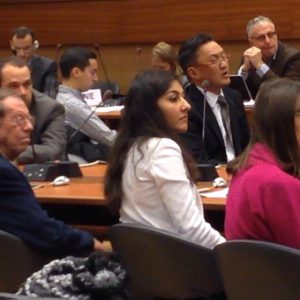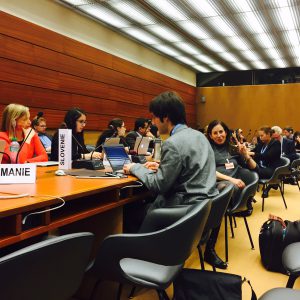Event
HRC31 side event – Implementing Human Rights Obligations Relating to the Environment

04 Mar 2016
13:00–15:00
Organization: Geneva Environment Network
The Permanent Mission of Costa Rica, Maldives, Morocco, Slovenia and Switzerland and the Special Rapporteur on human rights obligations relating to the enjoyment of a safe, clean, healthy and sustainable environment, Mr. John Knox, together with the United Nations Environment Programme and the Geneva Environment Network organized a side-event in the margins of the 31st session of the Human Rights Council on the implementing human rights obligations relating to the environment.
The side-event discussed the Special Rapporteur’s report (A/HRC/31/53) on implementing human rights obligations relating to the environment which describes possible methods of implementing human rights obligations relating to the enjoyment of a healthy environment. The proposals are addressed to: (a) the Human Rights Council and other international organizations; (b) regional human rights bodies and other regional organizations; (c) national governments; (d) civil society organizations; and (e) the Special Rapporteur himself.
Programme
Welcome by moderator
Ms. Shyami PUVIMANASINGHE, Office of the High Commissioner for Human Rights
Panel discussion
John H. KNOX, Special Rapporteur on human rights obligations relating to the enjoyment of a safe, clean, healthy and sustainable environment
Barbara FONTANA, Permanent Mission of Switzerland
Barbara RUIS, United Nations Environment Programme
Marc LIMON, Universal Rights Group
Marcos ORELLANA, Center for International Environment Law
Question and comments
Closing remarks
Discussion
In her introductory remarks Shyami Puvimanasinghe presented the pannelists. She mentioned that the report on implementation gives recommendations to different actors such as UN bodies, states and regional and national human rights bodies.
John Knox, Special Rapporteur explained what he has done so far during his mandate. He mentioned that the implementation of human rights norms relating to the environment is even more difficult than their conceptualization. After many consultations with different stakeholders, he issued a mapping report and a good practices report. Last year, the Human Rights Council renewed his mandate for another three years, upgraded his title from Independent Expert to Special Rapporteur, with additional responsibilities, namely promoting the implementation of and compliance with those human rights norms relating to the environment which are already delineated clearly enough.
He conducted an expert seminar with OHCHR and UNEP in October 2015, convening more than 20 experts, followed by a public consultation and written submissions. This year’s report on the implementation of human rights obligations relating to the environment is categorized according to the actors concerned.
He presented elements of the report and his proposals for the Human Rights Council:
- Use the universal periodic review procedures for human rights norms related to the environment.
- Adopt a new instrument specifically addressing these human rights. This idea however he considers to be premature since some norms are still in the developing process. A declaration would be more timely.
Concerning UNEP he said:
- UNEP already does work in judicial training, could do more there. It could provide model legislation on environmental provisions.
Concerning UNDP:
- There is no umbrella cooperation on this topic between different UN organizations. UNDP could act in such a function.They have bi-annual meetings each devoted to a specific theme. The next topic could be human rights and the environment.
Concerning UNITAR:
- Is developing an online course on the topic, together with SR, UNDP and UNEP.
At Regional levels:
- There is a lot going on on the regional level.
- Aarhus Convention and negotiations in Latin America and the Caribbean on a similar instrument: procedural rights to information, participation and remedy.
At States level:
- Coud adopt a constitutional right to a healthy environment.
- Establish environmental/green tribunals.
- Should protect environmental human rights defenders. Just yesterday, a human rights defender was murdered in Honduras.
There is already a lot of information available. All good practices from his previous report are collected in an easy accessible online Environmental Rights Database (ERDb).
Barbara Fontana mentioned that Switzerland has been involved in the initiative that led to John Knox’ mandate from the start. Switzerland reiterated that for states, the implementation of SDGs is a key opportunity to align their policies with human rights and environmental concerns.
- Two recent international developments which are important are the adoption of the 2030 Agenda which embodies the social, economic and environmental pillars, and the adoption of the Paris Agreement.
- Regarding the implementation report, the effectiveness of policy-making can be improved by following the recommendations of the report, which is one of the fundamental achievements of Knox’ mandate.
- For states, the implementation of SDGs is a key opportunity to align their policies with human rights and environmental concerns. Civil society is often under restrictions and they must be able to continue their work.
- The draft Human Rights Council resolution on human rights and the environment will hopefully be endorsed by consensus until the end of this session.
Marcos Orellana from CIEL confirmed that a number of these human rights norms relating to the environment have a sufficiently clear basis to continue with implementation. Human rights principles can inform the negotiation of multilateral environmental agreements by way of transparency and participation, the Aarhus Convention being a good model. As for the right to a healthy environment, there is no globally accepted definition due to the conditions that vary from country to country, making it difficult to agree on one general content. The situation for environmental human rights defenders needs improvement, as statistics show that two are killed each week. For the task of bringing the concepts developed at the UN level to the local level, national human rights organizations are best placed. Finally, there can be tensions between human rights and the environment, for example if people are displaced for the sake of the protection of an ecosystem. On communications he said that the ability to reach the Special Rapporteur is an important mechanism. It has been criticized for being ineffective, as countries do not respond when they receive the information from the SR. However, information becomes available, which is good.
Barbara Ruis of UNEP urged for bigger cooperation, as a selective linkage between human rights and the environment is not enough. She pointed out that human rights law and environmental law are quite different in their nature and suggested that the two fields of law could be aligned more with each other through, for instance, human rights and environmental performance reviews which take account of each other. We should further not shy away from using the term ‘environmental human rights defenders’ and recognizing a right to a healthy environment. She mentioned UNEP report on climate change and human rights, which was launched during the COP21 negotiations in Paris, on Human Rights Day.
Marc Limon of Universal Rights Group also recognized the importance of the work done by environmental human rights defenders, as they bring together the fields of human rights and the environment. The Universal Rights Group has identified three key points for implementation: 1) How to realize these norms: through voluntary guidelines, action plans, HRC resolutions, practical handbooks and through ensuring that these tools are accessible and comprehensible to domestic policy-makers and implementers as well as people who are directly affected, such as environmental human rights defenders. National human rights institutions are ideally placed to facilitate implementation; 2) Who should set the framework: the Special Rapporteur is the key player, with states and people at the regional and domestic level as target audience; 3) Where should we focus our efforts on: directly on the ground on the country level. vFora to share expertise would be good, held at the regional or local level by using UN country offices. Working with national human rights institutions is of particular importance.
A representative from the Mexican national human rights commission mentioned that two recommendations concerning procedural rights (prior and informed consent and air quality) were tackled in Mexico recently, and asked about the future foreseen in the context of national human rights institutions.
During the discussion Slovenia recalled the Geneva Pledge to facilitate dialogue with experts (33 states have joined).
More information and documents
More information on the report can be found at the Special Rapporteur’s OHCHR website.
Visit also the Special Rapporteur Database.
Visit the Special Rapporteur on the situation of human rights defenders website.
Download UNEP report on Climate change and human rights in pdf format.
https://www.genevaenvironmentnetwork.org/wp-content/uploads/2020/05/summary_imp_report_final.pdf






